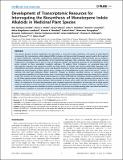Development of Transcriptomic Resources for Interrogating the Biosynthesis of Monoterpene Indole Alkaloids in Medicinal Plant Species
Author(s)
Gongora-Castillo, Elsa; Childs, Kevin L.; Fedewa, Greg; Hamilton, John P.; Liscombe, David K.; Magallanes-Lundback, Maria; Mandadi, Kranthi K.; Nims, Ezekiel; Runguphan, Weerawat; Vaillancourt, Brieanne; Varbanova-Herde, Marina; DellaPenna, Dean; McKnight, Thomas D.; O'Connor, Sarah Ellen; Buell, C. Robin; ... Show more Show less
DownloadGóngora-Castillo-2012-Development of Trans.pdf (997.9Kb)
PUBLISHER_CC
Publisher with Creative Commons License
Creative Commons Attribution
Terms of use
Metadata
Show full item recordAbstract
The natural diversity of plant metabolism has long been a source for human medicines. One group of plant-derived compounds, the monoterpene indole alkaloids (MIAs), includes well-documented therapeutic agents used in the treatment of cancer (vinblastine, vincristine, camptothecin), hypertension (reserpine, ajmalicine), malaria (quinine), and as analgesics (7-hydroxymitragynine). Our understanding of the biochemical pathways that synthesize these commercially relevant compounds is incomplete due in part to a lack of molecular, genetic, and genomic resources for the identification of the genes involved in these specialized metabolic pathways. To address these limitations, we generated large-scale transcriptome sequence and expression profiles for three species of Asterids that produce medicinally important MIAs: Camptotheca acuminata, Catharanthus roseus, and Rauvolfia serpentina. Using next generation sequencing technology, we sampled the transcriptomes of these species across a diverse set of developmental tissues, and in the case of C. roseus, in cultured cells and roots following elicitor treatment. Through an iterative assembly process, we generated robust transcriptome assemblies for all three species with a substantial number of the assembled transcripts being full or near-full length. The majority of transcripts had a related sequence in either UniRef100, the Arabidopsis thaliana predicted proteome, or the Pfam protein domain database; however, we also identified transcripts that lacked similarity with entries in either database and thereby lack a known function. Representation of known genes within the MIA biosynthetic pathway was robust. As a diverse set of tissues and treatments were surveyed, expression abundances of transcripts in the three species could be estimated to reveal transcripts associated with development and response to elicitor treatment. Together, these transcriptomes and expression abundance matrices provide a rich resource for understanding plant specialized metabolism, and promotes realization of innovative production systems for plant-derived pharmaceuticals.
Date issued
2012-12Department
Massachusetts Institute of Technology. Department of ChemistryJournal
PLoS ONE
Publisher
Public Library of Science
Citation
Gongora-Castillo, Elsa et al. “Development of Transcriptomic Resources for Interrogating the Biosynthesis of Monoterpene Indole Alkaloids in Medicinal Plant Species.” Ed. Leonardo Mariño-Ramírez. PLoS ONE 7.12 (2012).
Version: Final published version
ISSN
1932-6203